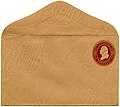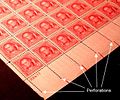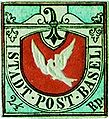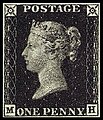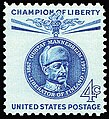Portal:Philately
| Philately portal | WikiProject Philately |
The Philately Portal
Philately is the study of revenue or postage stamps. This includes the design, production, and uses of stamps after they are issued. A postage stamp is evidence of pre-paying a fee for postal services. Postal history is the study of postal systems of the past. It includes the study of rates charged, routes followed, and special handling of letters.
Stamp collecting is the collecting of postage stamps and related objects, such as covers (envelopes, postcards or parcels with stamps affixed). It is one of the world's most popular hobbies, with estimates of the number of collectors ranging up to 20 million in the United States alone.
Epaulettes (French: Épaulettes, Dutch: Epauletten) is the name given by philatelists to the first series of postage stamps issued by Belgium. The stamps, which depicted King Leopold I with prominent epaulettes from which the name derives, became legally usable on 1 July 1849. Two denominations with the same design were issued simultaneously: a brown 10 centimes and a blue 20 centimes. They were produced as the result of a series of national reforms to the postal system in Belgium, based on the success of similar British measures adopted in 1840. The stamps allowed postal costs to be pre-paid by the sender, rather than the receiver, and led to a sharp increase in the volume of mail. Although quickly superseded by new types, Epaulettes proved influential and have since inspired several series of commemorative stamps. (Full article...)
Selected article -

Presidents of the United States have frequently appeared on U.S. postage stamps since the mid-19th century. The United States Post Office Department released its first two postage stamps in 1847, featuring George Washington on one, and Benjamin Franklin on the other. The advent of presidents on postage stamps has been definitive to U.S. postage stamp design since the first issues were released and set the precedent that U.S. stamp designs would follow for many generations.
The paper postage stamp itself was born of utility (in England, 1840), as something simple and easy to use was needed to confirm that postage had been paid for an item of mail. People could purchase several stamps at one time and no longer had to make a special trip to pay for postage each time an item was mailed. The postage stamp design was usually printed from a fine engraving and were almost impossible to forge adequately. This is where the appearance of presidents on stamps was introduced. Moreover, the subject theme of a president, along with the honors associated with it, is what began to define the stamp issues in ways that took it beyond the physical postage stamp itself and is why people began to collect them. There exist entire series of stamp issues whose printing was inspired by the subject alone. (Full article...)Selected images
Did you know (auto-generated)

- ... that in 1850, about a quarter of the post offices of the Swiss Post were located in taverns?
- ... that a new Christmas stamp that debuted in the 350-person town of Bethlehem, Georgia, in 1967 got so much attention that the two-employee post office had to hire forty-three temporary workers?
- ... that after the British Army captured New York City in 1776, Samuel Loudon fled to the village of Fishkill, where he founded the state's first post office?
- ... that both of Karl R. Free's New Deal-era U.S. post office murals with Native American subjects have been challenged as offensive?
- ... that after Irish post office clerk Maureen Flavin Sweeney reported worsening weather conditions, Dwight D. Eisenhower agreed to postpone D-Day by 24 hours?
- ... that Amrita Sher-Gil's painting Hill Women appeared on a 1978 Indian postage stamp?
General images -
Selected stamp -

The Dag Hammarskjöld invert is a 4 cent value postage stamp error issued on 23 October 1962 by the United States Postal Service (then known as the Post Office Department) one year after the death of Dag Hammarskjöld, Secretary-General of the United Nations, in an airplane crash. The stamp, showing the yellow background inverted relative to the image and text, is also known as the Day's Folly after Postmaster General J. Edward Day who ordered the intentional reprinting of the yellow invert commenting, "The Post Office Department is not running a jackpot operation."
The stamp reprint was in effect a deliberate error produced by the Post Office Department to avoid creating a rarity. It was decided to reprint 40 million of the inverted stamps after the discovery of the error so there would be no rarity factor in the inverted stamp and to prevent people profiting from the Postal Service's mistake. The reprints were issued to the public on 16 November and described as a Special Printing. (Full article...)List articles

- List of philatelists
- List of most expensive philatelic items
- List of postage stamps
- Lists of people on postage stamps (article) • (Category page)
- List of entities that have issued postage stamps (A–E)
- List of entities that have issued postage stamps (F–L)
- List of entities that have issued postage stamps (M–Z)
- List of postal services abroad
- Timeline of postal history
Related portals
Topics
Categories
WikiProject
![]() WikiProject Philately organizes the development of articles relating to philately. For those who want to skip ahead to the smaller articles, the WikiProject also maintains a list of articles in need of improvement or that need to be started. There are also many red inked topics that need to be started on the list of philatelic topics page.
WikiProject Philately organizes the development of articles relating to philately. For those who want to skip ahead to the smaller articles, the WikiProject also maintains a list of articles in need of improvement or that need to be started. There are also many red inked topics that need to be started on the list of philatelic topics page.
Selected works
- Williams, Louis N., & Williams, Maurice (1990). Fundamentals of Philately {revised ed.). American Philatelic Society. ISBN 0-9335-8013-4.
{{cite book}}: CS1 maint: multiple names: authors list (link) - Hornung, Otto (1970). The Illustrated Encyclopedia of Stamp Collecting. Hamlyn. ISBN 0-600-01797-4.
- Stuart Rossiter & John Fowler (1991). World History Stamp Atlas (reprint ed.). pub: Black Cat. ISBN 0-7481-0309-0.
Wikimedia
The following Wikimedia Foundation sister projects provide more on this subject:
-
Commons
Free media repository -
Wikibooks
Free textbooks and manuals -
Wikidata
Free knowledge base -
Wikinews
Free-content news -
Wikiquote
Collection of quotations -
Wikisource
Free-content library -
Wikiversity
Free learning tools
Other Portals
Sources
- ^ "Philatelic Collections: General Collections". British Library. 2003-11-30. Archived from the original on 30 June 2011. Retrieved 2011-01-16.







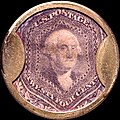

![Image 7Unissued 1956 £1 Jamaican chocolate and violet, the first stamp designed for Queen Elizabeth II. Held in the British Library Crown Agents Collection.[1]](http://upload.wikimedia.org/wikipedia/commons/thumb/9/9b/Stamp_Jamaica_1956_unissued_1sh.jpg/120px-Stamp_Jamaica_1956_unissued_1sh.jpg)



